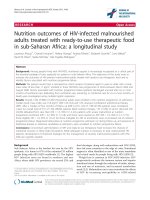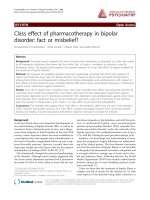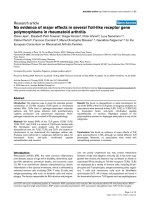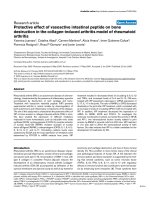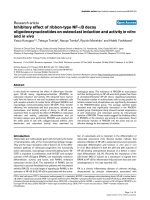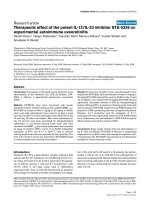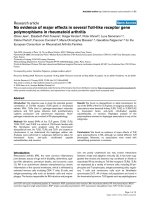Báo cáo y học: " No effect of short-term amino acid supplementation on variables related to skeletal muscle damage in 100 km ultra-runners - a randomized controlled trial" potx
Bạn đang xem bản rút gọn của tài liệu. Xem và tải ngay bản đầy đủ của tài liệu tại đây (260.27 KB, 8 trang )
RESEARCH ARTICLE Open Access
No effect of short-term amino acid
supplementation on variables related to skeletal
muscle damage in 100 km ultra-runners - a
randomized controlled trial
Beat Knechtle
1,2*
, Patrizia Knechtle
1
, Claudia Mrazek
1
, Oliver Senn
2
, Thomas Rosemann
2
, Reinhard Imoberdorf
3
and
Peter Ballmer
3
Abstract
Background: The purpose of this study was to investigate the effect of short-term supplementation of amino
acids before and during a 100 km ultra-marathon on variables of skeletal muscle damage and muscle soreness. We
hypothesized that the supplementation of amino acids before and during an ultra-marathon would lead to a
reduction in the variabl es of skeletal muscle damage, a decrease in muscle soreness and an improved
performance.
Methods: Twenty-eight experienced male ultra-runners were divided into two groups, one wi th amino acid
supplementation and the other as a control group. The amino acid group was supplemented a total of 52.5 g of
an amino acid concentrate before and during the 100 km ultra-marathon. Pre- and post-race, creatine kinase, urea
and myoglobin were determined. At the same time, the athletes were asked for subjective feelings of muscle
soreness.
Results: Race time was not different between the groups when controlled for personal best time in a 100 km
ultra-marathon. The increases in creatine kinase, ure a and myoglobin were not different in both groups. Subjective
feelings of skeletal muscle soreness were not different between the groups.
Conclusions: We concluded that short-term supplementation of amino acids before and during a 100 km ultra-
marathon had no effect on variables of skeletal muscle damage and muscle soreness.
Background
Apart from the classical marathon distance of 42.195
km, an increasing number of studies of athletes partici-
pating in ultra-marathons over 100 km [1-3] or further
[4-6] has been published in recent years. Based on the
high eccentric demands of these activities, marathon
and ultra-marathon running as eccentric exercise lead to
skeletal muscle damage resulting in an increase in myo-
cellular enzymes such as plasma creatine kinase [1,4,6],
urea [3,7,8], and myoglobin [1,7,9].
It has been shown that the breakdown of body protein
during endurance exercise occurs and the mobilized
amino acids are available for increased rates of oxidation
and gluconeogenesis during endurance performances
[10]. The increase in variables of skeletal muscle damage
during ultra-endurance running might be associated
with the decrease in skeletal muscle mass as has been
shown in ultra-marathoners [2,11,12].
In recent ye ars, several laboratory studies in cyclists
reported reductions of myocellular enzymes indicative of
skeletal muscle damage during endurance performances,
and enhanced performance after combined ingestion of
carbohydrates and p rotein. It has been demonstrated
that consumption of a carbohydrate-protein beverage
during an intense cycling performance led t o a reduced
increase in pl asma creatine kinase [13,14] and myoglo-
bin [15]. Subjects were given 200 ml of a carbohydrate
* Correspondence:
1
Gesundheitszentrum St. Gallen, St. Gallen, Switzerland
Full list of author information is available at the end of the article
Knechtle et al. Journal of the International Society of Sports Nutrition 2011, 8:6
/>© 2011 Knechtle et al; licensee BioMed Central Ltd. This is an Open Access article distributed under the terms of the Creative
Commons Attribution License ( which permits unrest ricted use, distribution, and
reproduction in any medium, provided the original work is properly cited.
(6%) or carbohydrate plus casein hydrolysate (6% carbo-
hydrate + 1.8% protein hydrolysate) 500 ml immediately
pre-exercise and every 5 km in the study of Saunders
et al. [15]. In the study of Valentine et al. [15], p artici-
pants consumed 250 ml placebo, carbohydrates (7.75%),
carbohydrate plus carbohydrates (9.69%) or carbohy-
drates plus protein (7.76% + 1.94%) every 15 min until
fatigue. The combined intake of carbohydrate and pro-
tein enhanced cycling performance [16,17] and reduced
ratings of muscle soreness [14]. The ingestion of amino
acids bef ore a performance reduced both delayed onset
of muscle soreness and muscle fatigue for several days
after exercise [18]. In addition, it was discovered that
amino acid supplementation during training prevented
exercise induced muscle proteolysis [19].
To date, no study has investigated whether the supple-
mentation of amino acids would have an effect on vari-
ables of skeletal muscle damage and performance in
ultra-endurance runners competing in events further
than the classic marathon distance. We therefore asked
whether the short-term supplementat ion of amino acids
before and durin g a 100 km ul tra- maratho n might have
an effect on variables of skeletal muscle damage i n
ultra-endurance athletes. Regarding the present litera-
ture, we hypothesized that the supplementation of
amino acids before and during an ultra-marathon would
lead to a reduced increase in the variables of skeletal
muscle damage, a decrease in muscle soreness and a n
improved performance.
Methods
An interventional field study at the ‘100 km Lauf Biel’
in Biel, Switzerland was used for this research. The
organizer contacted all participants of the race in 2009
via a separate newsletter at the time of inscription to
the race, in which they were asked to participate in
the st udy. About 1,000 male Caucasian runners started
in the race; a total of 30 male ultra-runners volun-
teered to participate in this investigation. This study
was approved by the Institutional Review B oard for
use of Human Subjects of the University of Berne,
Switzerland.
Subjects
A total of 28 athletes participated in this investigation.
Table 1 represents the anthropometric data for the par-
ticipants, Table 2 their pre-race training variables. The
athletes were informed of the experimental risks and
gave their informed written consent.
Measurements and Calculations
Ultra-runners volunteering for this investigation kept
a comprehensive trai ning dairy, including recording
their weekly training units in running, showing duration
(minutes) and distance (kilometres), from inscription to
the study until the start of the race. In addition, they
reported their number of fini shed 100 km runs including
their personal best time in a 100 km. ultra-marathon.
The personal best time was defined as the best tim e the
athletes ever had achieved in their active career as an
ultra-runner.
The athletes who agreed to participate were randomly
assigned to the amino acid supplementation group or
the control group upon inscription to the study. In case
an athlete withdrew, the next athlete filled the gap.
Twenty-eight of the expected 30 athletes reported to the
investigators at the race site, between 04:00 p.m. and
09:00 p.m. on June 12 2009.
The athletes in the group using amino acid supple-
mentation received, on the occasion of the pre-race
measurements, a pre-packed package o f amino acids in
the form of a commercial brand of tablets (amino-
loges
®
, Dr. Loges + Co. GmbH, 21423 Winsen (Luhe),
Germany). The composition of the product is repre-
sented in Table 3. These athletes ingested 12 tablets one
hour before the start of the race, and then four tablets
at each of the 17 aid stat ions. The runners took a total
of 80 tablets in the pockets of their race clothing. In
total, they ingested 52.5 g of amino acids; 20 g were
branched-chain amino acids. During the run, they con-
sumed food and fluids at the aid stations ad libitum.At
each aid station, they recorded their i ntake of nutrition
Table 1 Comparison of pre-race age and anthropometry
of the participants
Amino acids (n = 14) Control (n = 14)
Age (years) 42.4 (9.1) 45.1 (6.1)
Body mass (kg) 72.1 (6.4) 75.1 (5.6)
Body height (m) 1.74 (0.06) 1.80 (0.06)
Body mass index (kg/m
2
) 23.5 (1.5) 22.9 (2.2)
Percent body fat (%) 14.1 (3.0) 16.0 (4.5)
Results are presented as mean (SD). No significant differences were found
between the two grou ps.
Table 2 Comparison of pre-race training and experience
of the participants
Amino acids
(n = 14)
Control
(n = 14)
Years as active runner 13.1 (9.4) 10.3 (8.3)
Average weekly running volume (km) 81.6 (21.8) 60.0 (16.2)
Average weekly running volume (h) 7.4 (2.3) 5.7 (2.0)
Average speed in running during
training (km/h)
10.9 (1.8) 11.2 (1.1)
Number of finished 100 km runs 5.7 (5.1) (n = 10) 2.8 (2.3)
(n = 8)
Personal best time in a 100 km
run (min)
601 (107) 672 (98)
Results are presented as mean (SD). No significant differences were found
between the two grou ps.
Knechtle et al. Journal of the International Society of Sports Nutrition 2011, 8:6
/>Page 2 of 8
and fluid. Due to the manufacturer’s concerns regarding
the high calcium content of the placebo tablets which,
in combination with an expected dehydration, could be
harmful for the renal function of the athletes, we had to
resign from a placebo control. Thus the athletes ran-
domly assigned to the control group also consumed
food and f luids at libitum and recorded their nutrient
and fluid intake, but did not receive any placebo tablets.
Twenty-eight of the expected 30 athletes reported,
between 04:00 p. m. and 09:00 p.m. on June 12 2009 to
the investigators for their pre-race anthropometric mea-
surements and the collection of blood s amples. Upon
arrival at the finish, the same measurements were per-
formed within one hour after finishing, there being 27
finishers.
Questionnaires of subjective feelings
In combination with the pre- and post-race measure-
ments, the athletes were asked about their subjective
feelings of muscle soreness, using a subjective 0-20 scale
from 0 (absolutely no muscle soreness) to 20 (highest
subjective discomfort with muscle soreness). After the
race, the athletes were asked whether they had per-
formed the run as expected, weaker than expected or
better than expected.
Anthropometric measurements
Body mass was measured using a commercial scale
(Beurer BF 15, Beurer GmbH, Ulm, G ermany) to the
nearest 0.1 kg. Body height was determined using a sta-
diometer to the nearest 1 cm. Body mass index (kg/m
2
)
was calculated using body mass and body height.
The percentage of body fat was estimated using the
following anthropometric formula according to Ball
et al.: Percent body fat = 0.465 + 0.180 * (Σ7SF) -
0.0002406 * (Σ7SF)
2
+ 0.0661 * (age), where Σ7SF = sum
of skin-fold thickness of pectoralis,axilla,triceps,sub
scapular, abdomen, suprailiac and thigh [20]. Skin-fold
data were obtained using a skin-fold caliper (GPM-
Hautfaltenmessgerät, Siber & Hegner, Zurich, Switzer-
land) and recorded to the nearest 0.2 mm. One trained
investigator took all the anthropometric measurements
in order to eliminate inter-tester variability. The skin-
fold measurements were taken once for the entire eight
skin-folds and were then repeated twice more by the
same investigator; the mean of the three times was then
used for the analyses. The timing of the taking of the
skin-fold measurements was standardized to ensure
reliability, and the readings were performed after 4 s fol-
lowing Becque et al. [21].
Analysis of blood samples
After venipuncture of an antecubital vein in the right
arm while the participants were seated, two Sarstedt
S-Monovettes (serum gel, 7.5 ml) for chemical analysis
were drawn. Monovettes for serum were centrifuged
at 3,000 g for 10 min at 4°Celsius. The serum was col-
lected, stored on ice and transported immediately after
collection to the laboratory for analysis within 6 hours.
In the serum, urea, creatine kinase, and myoglobin
were measured usi ng COBAS IN TEGRA
®
800 (Roche,
Mannheim, Germany).
Estimation of energy intake and energy expenditure
During the run, the athletes consumed food and drinks
ad libitum and reported t heir intake of fluids and solid
nutrition at each aid station. At these aid stations,
liquids and food such as hypotonic sports drinks, t ea,
soup caffeinated drinks, wate r, bananas, oranges, energy
bars and bread were prepared in a standardized manner,
i.e. beverages and food were provided in standardized
size portions. The drinking cups were filled to 0.2 L; the
energy bars and the fruits were halved. Ingestion of
fluids and solid food were determined ac cording to the
reports of the athletes using a food table [22]. Energy
expenditure during the event was estimated using body
mass, mean velocity and time spent running [23].
Statistical Analyses
The Shapiro-Wilk test was used to check for normality
distribution. Data is presented as mean and standard
deviation (mean ± SD). Parametric- and non-parametric,
both within a group (pre-compared to post-race) and
between groups (differences during the race between the
supplementation and control group), comparisons were
performed as appropriate. Correlation analyses were
applied in order to investigate the effect of the amino
acid supplementation on the variables of skeletal muscle
damage and changes in anthropometry. In addition we
calculated Cohen’ s ƒ
2
as an appropriate effect size that
can be applied in the context of multiple regressions to
estimate the relative importance of the differences
between the two groups. By convention, ƒ
2
effect sizes
of 0.02, 0.15, and 0.35 are termed small, medium, and
Table 3 Composition of the amino acid supplementation
Amino acid Per Tablet (mg) During the whole race (g)
L-Leucine 125 10
L-Ornithine 62.5 5
L-Isoleucine 62.5 5
L-Valine 62.5 5
L-Arginine 62.5 5
L-Choline 31.25 2.5
L-Cysteine 50 4
L-Tyrosine 50 4
L-Lysine 31.25 2.5
L-Phenylalanine 31.25 2.5
L-Threonine 31.25 2.5
L-Histidine 31.25 2.5
L-Methionine 12.5 1
L-Tryptophan 12.5 1
Knechtle et al. Journal of the International Society of Sports Nutrition 2011, 8:6
/>Page 3 of 8
large, respectively [24]. Fisher’ sexacttestwasapplied
for categorical data to assess the effect of amino-acid
supplementation on the subjective estimation of race
outcome. Statistical significance was set at a two-sided
p-level < 0.05 for all comparisons.
Results
Baseline characteristics with regard to anthropometry
(Table 1) training and pre-race experience (Table 2)
showed no differences between the athletes receiving
amino acid supplementation and the control group.
Performance
One athlete in the control group dropped out after
71 km due to medical problems. Mean (±SD) finishing
time of the 14 athletes in the amino acid group was
624.3 (79.5) min ., whereas the remaining 13 athletes out
of the control group finished in 697.8 (89.7) min. The
mean difference of 73.6 min. in race time between
the two groups was statistically significant (p = 0.033).
The corresponding 95% confidence limits of the race
time difference were between 6.5 min. and 140.6 min.
Race time was significantly associated with personal best
time in a 100 km ultra-marathon for both the supple-
mentation and the control group, with Pearson correla-
tion coefficients of 0.77 and 0.81 (p < 0.05 for both),
respectively. The corresponding mean (95% CI) differ-
ence in personal best time betwe en the groups was 71.0
(-33.2 to 175.1) min (p = 0.17). Due to the similar mean
differences in race time and personal best time in a
100 km ultra-marathon between the two groups, and
the significant association between the race time and
thepersonalbesttimeina100kmultra-marathon,we
performed a linear regression controlling for personal
best time in a 100 km ultra-marathon as a potential
confounder for the difference between 100 km ra ce
times. The resulting mean (SE) race time difference of
5.5 (±28.6) min. remained no longer statistically signifi-
cant when adjusted for the personal best time in a
100 km ultra-marathon.
Energy balance and fluid intake
The athletes in the amino acid group consumed 8.5
(±3.2) L of fluids during the run, the runners in the con-
trol group 7.9 (±3.5) L (p > 0.05). Energy intake, energy
expenditure and energy balance were not different
between the two groups (Table 4). The athletes in the
amino acid group ingested significantly more protein
compared to the control group. The energy deficit was
sig nificant ly related to the decrease in body mass of the
runners in the amino acid group (Pearson r =0.7,p =
0.003). The additional effect (Cohen’s ƒ
2
)oftheamino
acid supplementation on the association between the
loss of body mass and the energy deficit was 0.018. In
the amino acid group, body mass decreased by 1.8
(±1.6) kg , in the control gr oup by 1.9 (±2. 0) kg (p >
0.05). No associations between the 100 km race time
and the change in bo dy mass have been observed in the
two groups.
Changes in serum variables
Plasma concentrations of creatine kinase, urea and myo-
globin decreased significantly in the two groups (Table 5).
The changes from post- to pre-race (Δ) were no different
between the two groups. The post-race values for creatine
kinase, serum urea and myoglobin were 2,637 (±1,278) %,
175 (±32) %, and 14,548 (±8,522) % higher than the pre-
race values in the amino acid group; and 2,749 (±1,962) %,
168 (±38) %, and 13,435 (±10,724) % in the control group
(p < 0.01). The increases were not different between the
two groups.
In the amino acid group, race time was positively cor-
related to the increase in plasma urea concentration
(Pearson r =0.56,p = 0.038), which was not the case in
the control group (Pearson r = -0.30, p =0.3).Thecor-
responding effect size (Cohen’s ƒ
2
) for the observed dif-
ference between the race time and the change in urea
concentration between the two groups was 0.23.
Subjective feelings of muscle soreness and performance
In the amino acid group, the subjective feeling of muscle
soreness increased from 0.9 (±2.2) pre-race to 11.3
(±4.3) post-race (p < 0.05); in the control group from
0.4 (±1.0) pre-race to 9.4 (±4.6) post-race (p < 0.05).
The changes between the two groups were not different.
When the athletes were asked, post-race, whether they
had completed the race as expected, better than
expected or worse than planned, no differences were
found.
Discussion
In the present study, we have investigated the potential
effects of a short term amino-acid supplementation on
variables of skeletal muscle damage in ultra-runners
during a 100 km ultra-marathon. We hypothesized that
Table 4 Comparison of energy balance and nutrient
intake of the participants during the race
Amino acids (n = 14) Control (n = 13)
Energy expenditure (kcal) 7,160 (844) 7,485 (621)
Energy intake (kcal) 3,311 (1,450) 2,590 (1,334)
Energy balance (kcal) - 3,848 (1,369) - 4,894 (1,641)
Intake of carbohydrates (g) 755.7 (354.8) 608.8 (326.4)
Intake of protein (g) 79.9 (12.7) ** 26.7 (22.0)
Intake of fat (g) 5.1 (4.8) 7.0 (7.1)
Results are presented as mean (SD). Athletes in the amino acid group
ingested highly significantly more protein compared to the control group.
** = p < 0.01.
Knechtle et al. Journal of the International Society of Sports Nutrition 2011, 8:6
/>Page 4 of 8
the supplementation of amino acids before and during
an ultra-marathon would reduce the increase in the
variables of skeletal muscle damage, decrease the subjec-
tive feeling of muscle soreness and improve race perfor-
mance. In contrast to our hypothesis, the amino acid
supplementation showed no effect on variables of skele-
tal muscle dam age, i.e. creatine k inase and myoglobin,
on subjective feelings of muscle soreness and on perfor-
mance. Potential explanations for these negative findings
could be the time and duration of amino acid supple-
mentation and the type of exercise.
Change in variables of skeletal muscle damage
We hypothesized tha t an amin o acid supplementation
would lower post-race values of variables of skeletal
muscle damage compared to control participants. In
contrast, we found no differenc es in the increase in
serum concentrations of creatine kinase, urea and myo-
globin between the two groups. Cockburn et al. demon-
strated t hat creatine kinase and myoglobin increased to
a lower extent after supplementation with a milk-based
protein [25]. However, they measured creatine kinase
and myoglobin 24 h and 48 h after exercise, which
might explain the disparate findings.
In marathon runners, post-race creatine kinase was
significantly elevated among faster compared to slower
runners and the elevations of creatine kinase drawn
24 hours after a marathon were inversely related to the
finishing times [26]. Skenderi et al. described 39 runners
in the Spartathlon, a 246 km ultra-marathon, which the
athletes completed within 33.3 (±0.5) h [6]. The finish-
ing time was not correlated to the post race creatine
kinase concentration, as has been found in the present
study.
Duration of amino acid supplementation
Our athletes ingested the amino acids as a pre-race l oad
of 12 g and then 4 g at each aid station during the
100 km ultra-marathon. The total amount was 52.5 g
amino acids and the time of supplementation was
between 12 and 13 hours. This time period might be too
short to show an effect of the amino acid supplementation
on performance. An amino acid supplementation period
of two weeks [27], four weeks [28] or even eight weeks
[29] showed beneficial effects on performance. The sup-
plementation of amino acids for a shorter period may
nonetheless have positive effects on serum variables or
muscle soreness. Shimomura et al. demonstrated that the
ingestion of 5 g of branched-chain amino acids 15 minutes
prior to seven sets of 20 squats per set reduced the delayed
onset of muscle soreness and muscle fatigue for several
days after exercise [18].
The duration of supplementation might also h ave
been too short to show an effect on creatine kinase.
Consuming 12 g of branched-chain amino acids during
seven days reduced the increase of creatine kinase and
lactate dehydrogenase after performance [30]. Ohtani
et al. showed a decrease in post exercise creatine
kinase serum concentrations compared to pre-exercise
when athletes ingested, three times per day, 2.2 g of a
mixture of amino acids during one month [28]. How-
ever, there is data that shows that the ingestion of
amino acids during performance has an ef fect on vari-
ables of skeletal muscle damage. In a recent study in
untrained male cyclist, the ingestion of branched-chain
amino acids reduced the increase in creatine kinase
serum concentration after performance [31]. The dis-
parate findings might be explained by the fact that
those researchers investigated u ntrained subjects dur-
ing cycling where as we investigated well-trained and
experienced ultra-runners.
Two recent studi es showed an enhanced performance
when both protein and carbohydrates were ingested
during endurance performances. In two studies of
cyclists, the combined intake of carbohydrate and pro-
tein during exercise enhanced performance [16,17]. In
the first study of Saunders et al., the subjects were given
a carbohydrate and protein beverage with 7.3% carbohy-
drate and protein plus 1.8% protein concentrate versus a
carbohydrate-only beverage with 7.3% carbohydrate [16].
In the second study o f Saunders et al. ,thesubjects
received at 15 min intervals carbohydrate or carbohy-
drate and protein gels which were matched for carbohy-
drate content with 0.15 g carbohydrates·kg body mass
-1
Table 5 Comparison of changes of blood variables during the race within and between the two groups
Amino acids (n = 14) Control (n = 13) Difference between
changes
Pre race Post race Δ (post - pre
race)
Pre race Post race Δ (post - pre
race)
(Δ amino acids - Δ
control)
Creatine kinase (U/l) 168.3
(61.7)
4,582.5
(3,150.3)
4,414 (3,107) ** 157.8
(74.5)
3,861.5
(2,357.8)
3,703 (2,340) ** 711 (1,065)
Urea (mmol/l) 6.2 (1.4) 10.6 (2.1) 4.4 (1.6) ** 5.9 (1.5) 9.5 (1.6) 3.6 (1.5)** 0.8 (0.6)
Myoglobin (μg/l) 50.2 (17.8) 6,933 (4,208) 6,883 (4,206) ** 43.8 (13.0) 5,709 (4,053) 5,665 (4,049) ** 1,218 (1,591)
Results are presented as means (SD) for within group comparisons and as means (SE) for between group comparisons; * = p < 0.05; ** = p < 0.001, respectively
for within group comparisons. No significant differences were found when the Δ between the two groups was compared.
Knechtle et al. Journal of the International Society of Sports Nutrition 2011, 8:6
/>Page 5 of 8
for the carbohydrate group versus 0.15 g carbohydrates
+ 0.038 g protein·kg body mass
-1
for the carbohydrate
plus protein group [17]. In contrast to these findings,
four studies demonstrated no improved performance
after protein supplementation. In three studies using
cyclists [13,32,33] and one study using runners [34], the
intake of carbohydrate and protein did not enhance per-
formance compared to carbohydrate intake. In accor-
dance with our findings we must assume that protein
supplementation during endurance exercise has no
effect on performance.
Amino acid supplementation and muscle soreness
We hypothesized that the subjective feelings of muscle
soreness after the race would decrease while ingesting
amino acids. In cyclists, the combined intake of carbo-
hydrate and protein during performance led to signifi-
cant reductions in muscle soreness compared to
carbohydrate intake alone [14]. The supplementation
with amino acids before and after elbow flexion lowered
muscle soreness in the recovery phase [35]. In a study
with branched-chain amino acid supplementation during
performance, the subjects’ ratings of perceived exertion
were 7% lower when branched-chain amino acids were
given compared to c ontrols [36]. In contrast to these
findings, amino acid supplementation showed no ef fect
on muscle soreness in our ultra-runners. This might be
explained by the fact that we ha ve investigated runn ers
and not cyclists [14] and asked for subjective feelings of
muscle soreness immediately upon arrival at the finish
line, compared to the recovery phase [35].
Limitations of the present study and implications for
future research
The f inding that athlet es in the amino acid group were
significantly faster compared to the control group was
not brought about by t he ingestion of amino acids but
by the study sample. Although the athletes were ran-
domly assigned to the two groups and no statistically
significant differences regarding anthropometry and pre-
race experience were found between the two groups, we
a ssume a potential confounding caused by the personal
best time in a 100 km ultra-mar athon. The mean differ-
ence of 73.6 min. in race time between the two groups
was statistical ly significant. The corresponding 95% con-
fidence limits of the race time difference were between
6.5 min. and 140.6 min. The race time was significantly
associated with the personal best time in a 100 km
ultra-marathon for both groups. The corresponding
mean (95% CI) difference in personal best time between
the two groups was 71.0 (-33.2 to 175.1) min (p = 0.17).
Due to the similar mean differences in race time and
personal best time over 100 km between the two groups,
and the significant association between the race time
and the personal best time in a 100 km ul tra-marathon,
linear regression controlling for personal best time in a
100 km ultra-marathon as a potential confounder for
the difference between 100 km race times revealed that
the resulting mean (SE) race time difference of 5.5
(±28.6) min. remained no lon ge r statistically significant
when adjusted for the personal best time in a 100 km
ultra-marathon. Perso nal best time proved to b e an
important variable regarding performance in ultra-
endurance races [37]. Thus, adjusting for personal best
time resulted in a non-significant difference in race time
between the two groups.
The number of athletes might also have affected the
result. A decrease of 0.6 kg in body mass seems to be rele-
vant. In a recent study of male 100 km ultra-marathoners,
skeletal muscle mass decreased by 0.7 kg [2]. Regarding
statistical power, we would have needed to include 42 sub-
jects per group to detect a clinical relevant difference
between the groups of 80% power. With our actual sample
size, we had only 60% power. However, it was not possible
to increase the sample of athletes u nder field conditions
since only these 28 ultra-marathoners from the total field
of athletes volunteered to participate.
Since variables of skeletal muscle damage, such as
creatine kinase and myoglobin, remain increased for up
to seven days after a marathon [ 38], they should be
measured not only immediately after the race but also
in the recovery phase. Presumably the intake of amino
acids during the race would lead to lower values of crea-
tine kinase and myoglobin in the recovery phase.
In a multi-stage ultra-endurance run, skeletal muscle
mass decreased continuously throughout the race [11,12].
Presum ably, amino acid supple mentation would have an
effect on variables of skeletal muscle damage rather in a
multi-stage race than in a single ultra-marathon. It has
been shown that the oral administration of amino acids
resulted in a faster recovery of muscle strength after
eccentric exercise [39]. The ingestion of protein during
rest periods might enhance recovery [40]. In runners,
especially, the combined ingestion of carbohydrate and
protein after each training session over 6 days reduced the
post exercise increase in serum creatine kinase and muscle
soreness [34].
Conclusions
The ingestion of 52.5 g of amino acids immediately
before and during a 100 km ultra-marathon had no ben-
eficial effect o n variables of skeleta l muscle damage,
muscle soreness, and race performance. A positive effect
of amino acid supplementation in ultra-runners might
be expected when amino acid or protein would be sup-
plemented in the rest period during a multi-stage ultra-
endurance run. Recovery might be enhanced and
increase in variables of skeletal muscle damage might be
Knechtle et al. Journal of the International Society of Sports Nutrition 2011, 8:6
/>Page 6 of 8
reduced, effects that should be investigated in future
studies.
Acknowledgements
We thank Mary Miller for her help in translation.
Author details
1
Gesundheitszentrum St. Gallen, St. Gallen, Switzerland.
2
Institute of General
Practice and Health Services Research, University of Zurich, Zurich,
Switzerland.
3
Departement Medizin, Klinik für Innere Medizin, Kantonsspital
Winterthur, Switzerland.
Authors’ contributions
BK designed the study and wrote the manuscript. PK and CM carried out
blood analysis and assisted the manuscript preparation. OS was responsible
for statistical analysis and manuscript preparation. TR assisted the design of
the study and manuscript preparation. RI and PB assisted in data analysis,
data interpretation and manuscript preparation. All authors have read and
approved the final manuscript.
Competing interests
The authors declare that they have no competing interests.
Received: 24 November 2010 Accepted: 7 April 2011
Published: 7 April 2011
References
1. Gerth J, Ott U, Fünfstück R, Bartsch R, Keil E, Schubert K, Hübscher J,
Scheucht S, Stein G: The effects of prolonged physical exercise on renal
function, electrolyte balance and muscle cell breakdown. Clinical
Nephrology 2002, 57:425-431.
2. Knechtle B, Wirth A, Knechtle P, Rosemann T: Increase of total body
water with decrease of body mass while running 100 km nonstop -
formation of edema? Research Quarterly for Exercise and Sport 2009,
80:593-603.
3. Rama R, Ibáňez J, Riera M, Prats MT, Pagés T, Palacios L: Hematological,
electrolyte, and biochemical alterations after a 100-km run. Canadian
Journal of Applied Physiology 1994, 19:411-420.
4. Kim HJ, Lee YH, Kim CK: Biomarkers of muscle and cartilage damage and
inflammation during a 200 km run. European Journal of Applied Physiology
2007, 99:443-447.
5. Roth HJ, Leithäuser RM, Doppelmayr H, Doppelmayr M, Finkernagel H, von
Duvillard SP, Korff S, Katus HA, Giannitsis E, Beneke R: Cardiospecificity of
the 3
rd
generation cardiac troponin T assay during and after a 216 km
ultra-endurance marathon run in Death Valley. Clinical Research in
Cardiology 2007, 96:359-364.
6. Skenderi KP, Kavouras SA, Anastasiou CA, Yiannakouris N, Matalas AL:
Exertional rhabdomyolysis during a 246-km continuous running race.
Medicine and Science in Sports and Exercise 2006, 38:1054-1057.
7. Reid SA, King MJ: Serum biochemistry and morbidity among runners
presenting for medical care after an Australian mountain ultramarathon.
Clinical Journal of Sport Medicine 2007, 17:307-310.
8. Uberoi HS, Dugal JS, Kasthuri AS, Kolhe VS, Kumar AK, Cruz SA: Acute renal
failure in severe exertional rhabdomyolysis. The Journal of the Association
of Physicians of India 1991, 39:677-679.
9. Fellmann N, Sagnol M, Bedu M, Falgairette G, Van Praagh E, Gaillard G,
Jouanel P, Coudert J: Enzymatic and hormonal responses following a 24
h endurance run and a 10 h triathlon race. European Journal of Applied
Physiology 1988, 57:545-553.
10. Dohm GL, Tapscott EB, Kasperek GJ: Protein degradation during
endurance exercise and recovery. Medicine and Science in Sports and
Exercise 1987, 19:S166-S171.
11. Knechtle B, Kohler G: Running 338 kilometres within f ive days has
no effect on body mass and body fat but reduces skeletal muscle
mass - the Isarrun 2006. Journal of Sports Science and Medicine 2007,
6:401-407.
12. Knechtle B, Duff B, Schulze I, Kohler G: A multi-stage ultra-endurance run
over 1,200 km leads to a continuous accumulation of total body water.
Journal of Sports Science and Medicine 2008, 7:357-364.
13. Romano-Ely BC, Todd MK, Saunders MJ, Laurent TS: Effect of an isocaloric
carbohydrate-protein-antioxidant drink on cycling performance. Medicine
and Science in Sports and Exercise 2006, 38:1608-1616.
14. Saunders MJ, Moore RW, Kies AK, Luden ND, Pratt CA: Carbohydrate and
protein hydrolysate coingestions improvement of late-exercise time-trial
performance. International Journal of Sport Nutrition and Exercise
Metabolism 2009, 19:136-149.
15. Valentine RJ, Saunders MJ, Todd MK, St Laurent TG: Influence of
carbohydrate-protein beverage on cycling endurance and indices of
muscle disruption. International Journal of Sport Nutrition and Exercise
Metabolism 2008, 18:363-378.
16. Saunders MJ, Kane MD, Todd MK: Effects of a carbohydrate-protein
beverage on cycling endurance and muscle damage. Medicine and
Science in Sports and Exercise 2004, 36:1233-1238.
17. Saunders MJ, Luden ND, Herrick JE: Consumption of an oral carbohydrate-
protein gel improves cycling endurance and prevents postexercise
muscle damage. Journal of Strength and Conditioning Research 2007,
21:678-684.
18. Shimomura Y, Yamamoto Y, Bajotto G, Sato J, Murakami T, Shimomura N,
Kobayashi H, Mawatari K: Nutraceutical effects of branched-chain amino
acids on skeletal muscle. The Journal of Nutrition
2006, 136:529S-532S.
19.
Tang FC: Influence of branched-chain amino acid supplementation on
urinary protein metabolite concentrations after swimming. Journal of the
American College of Nutrition 2006, 25:188-194.
20. Ball SD, Altena TS, Swan PD: Comparison of anthropometry to DXA: a
new prediction equation for men. European Journal of Clinical Nutrition
2004, 58:1525-1531.
21. Becque MD, Katch VL, Moffatt RJ: Time course of skin-plus-fat
compression in males and females. Human Biology 1986, 58:33-42.
22. Kirchhoff E: Online-Publication of the German Food Composition Table
‘Souci-Fachmann-Kraut’ on the Internet. Journal of Food Composition and
Analysis 2002, 15:465-472.
23. Williams MH: Nutrition for Fitness and Sport. Brown & Benchmark
Publishers, USA;, fourth 1995.
24. Cohen J: Statistical Power Analysis for the Behavioral Sciences. Lawrence
Erlbaum Associates, Hillsdale, New Jersey Hove and London;, second 1988.
25. Cockburn E, Hayes PR, French DN, Stevenson E, St Clair Gibson A: Acute
milk-based protein-CHO supplementation attenuates exercise-induced
muscle damage. Applied Physiology, Nutrition, and Metabolism 2008,
33:775-783.
26. Siegel AJ, Silverman LM, Lopez RE: Creatine kinase elevations in marathon
runners: relationship to training and competition. The Yale Journal of
Biology and Medicine 1980, 53:275-279.
27. Skillen RA, Testa M, Applegate EA, Heiden EA, Fascetti AJ, Casazza GA:
Effects of an amino acid carbohydrate drink on exercise performance
after consecutive-day exercise bouts. International Journal of Sport
Nutrition and Exercise Metabolism 2008, 18:473-492.
28. Ohtani M, Maruyama K, Suzuki S, Sugita M, Kobayashi K: Changes in
haematological parameters of athletes after receiving daily dose of a
mixture of 12 amino acids for one month during the middle- and long-
distance running training. Bioscience, Biotechnology, and Biochemistry 2001,
65:348-355.
29. Lehmkuhl M, Malone M, Justice B, Trone G, Pistilli E, Vinci D, Haff EE,
Kilgore JL, Haff GG: The effects of 8 weeks of creatine monohydrate and
glutamine supplementation on body composition and performance
measures. Journal of Strength and Conditioning Research 2003, 17:425-438.
30. Coombes JS, McNaughton LR: Effects of branched-chain amino acid
supplementation on serum creatine kinase and lactate dehydrogenase
after prolonged exercise. The Journal of Sports Medicine and Physical Fitness
2000, 40:240-246.
31. Greer BK, Woodard JL, White JP, Arguello EM, Haymes EM: Branched-chain
amino acid supplementation and indicators of muscle damage after
endurance exercise. International Journal of Sport Nutrition and Exercise
Metabolism 2007, 17:595-607.
32. Osterberg KL, Zachwieja JJ, Smith JW: Carbohydrate and carbohydrate +
protein for cycling time-trial performance.
Journal of Sports Sciences 2008,
26:227-233.
33.
Luden ND, Saunders MJ, Todd MK: Postexercise carbohydrate-protein-
antioxidant ingestion decreases plasma creatine kinase and muscle
soreness. International Journal of Sport Nutrition and Exercise Metabolism
2007, 17:109-123.
Knechtle et al. Journal of the International Society of Sports Nutrition 2011, 8:6
/>Page 7 of 8
34. Van Essen M, Gibala MJ: Failure of protein to improve time trial
performance when added to a sports drink. Medicine and Science in
Sports and Exercise 2006, 38:1476-1483.
35. Nosaka K, Sacco P, Mawatari K: Effects of amino acid supplementation on
muscle soreness and damage. International Journal of Sport Nutrition and
Exercise Metabolism 2006, 16:620-635.
36. Blomstrand E, Hassmén P, Ek S, Ekblom B, Newsholme EA: Influence of
ingesting a solution of branched-chain amino acids on perceived
exertion during exercise. Acta Physiologica Scandinavica 1997, 159:41-49.
37. Knechtle B, Knechtle P, Rosemann T, Senn O: Personal best time, not
anthropometry or training volume, is associated with race performance
in a Triple Iron Triathlon. Journal of Strength and Conditioning Research
2010.
38. Lijnen P, Hespel P, Fagard R, Lysens R, Vanden Eynde E, Goris M,
Goossens W, Lissens W, Amery A: Indicators of cell breakdown in plasma
of men during and after a marathon race. International Journal of Sports
Medicine 1988, 9:108-113.
39. Sugita M, Ohtani M, Ishii N, Maruyama K, Kobayashi K: Effect of a selected
amino acid mixture on the recovery from muscle fatigue during and
after eccentric contraction exercise training. Bioscience, Biotechnology, and
Biochemistry 2003, 67:372-375.
40. Buckley JD, Thomson RL, Coates AM, Howe PR, Denichilo MO, Rowney MK:
Supplementation with a whey protein hydrolysate enhances recovery of
muscle force-generating capacity following eccentric exercise. Journal of
Science and Medicine in Sport 2010, 13:178-181.
doi:10.1186/1550-2783-8-6
Cite this article as: Knechtle et al.: No effect of short-term amino acid
supplementation on variables related to skeletal muscle damage in 100
km ultra-runners - a randomized controlled trial. Journal of the
International Society of Sports Nutrition 2011 8:6.
Submit your next manuscript to BioMed Central
and take full advantage of:
• Convenient online submission
• Thorough peer review
• No space constraints or color figure charges
• Immediate publication on acceptance
• Inclusion in PubMed, CAS, Scopus and Google Scholar
• Research which is freely available for redistribution
Submit your manuscript at
www.biomedcentral.com/submit
Knechtle et al. Journal of the International Society of Sports Nutrition 2011, 8:6
/>Page 8 of 8


